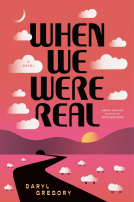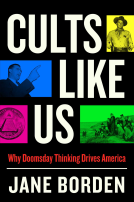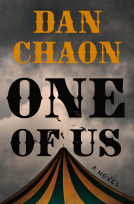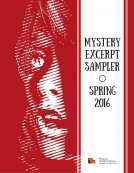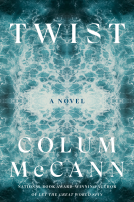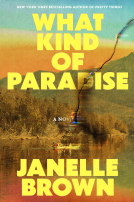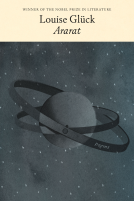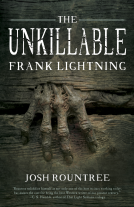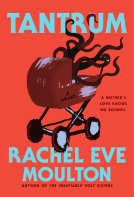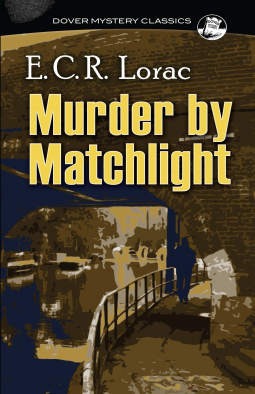
Murder by Matchlight
by E.C.R. Lorac
This title was previously available on NetGalley and is now archived.
Send NetGalley books directly to your Kindle or Kindle app
1
To read on a Kindle or Kindle app, please add kindle@netgalley.com as an approved email address to receive files in your Amazon account. Click here for step-by-step instructions.
2
Also find your Kindle email address within your Amazon account, and enter it here.
Pub Date Jul 15 2015 | Archive Date Dec 08 2015
Description
Thus begins this chilling mystery from the Golden Age of Detective Fiction by Edith Caroline Rivett, author of more than seventy books written under the pseudonyms of E. C. R. Lorac and Carol Carnac. Murder by Matchlight features Scotland Yard's imperturbable Chief Inspector Robert Macdonald, who is tasked with finding the killer of the man on the bridge. His only evidence: a set of bicycle tracks that come to an abrupt end. His suspects: a colorful cast that includes the shy, soft-spoken witness, a respected London physician, a screenwriter, an unemployed laborer, and a vaudevillian specializing in illusions — a lively group whose questionable activities will keep readers guessing until the final twist and turn of this deftly plotted whodunit.
Available Editions
| EDITION | Paperback |
| ISBN | 9780486255774 |
| PRICE | $9.95 (USD) |
Average rating from 22 members
Featured Reviews
 Critter B, Librarian
Critter B, Librarian
Murder by Matchlight is a fascinating and challenging mystery set in Word War II London.
A murder that seems rather impossible. Competent and methodical police detectives. A wide variety suspects and people of interest, including magicians, doctors, historians, out-of-work snoops and a commando. All set among bombing runs and the blackout.
On an inky November night of compulsory blackout in wartime London, a chemist takes an impromptu jaunt through the park after hearing news that his lady is unable to attend their dinner meeting. Hoping the cool air will alleviate his pensiveness, he sits for a while to think when bizarre events commence.
The setting is thoroughly connected to the where, when, why and how of the mystery, and quite nicely rounds out the characters of all involved. Detective Macdonald capably takes facts and people in hand with no bravado or eccentricity. Overall, an enjoyable read with no weak points.
 Judith L, Reviewer
Judith L, Reviewer
This novel is a prime example of the good mysteries I find when I seek out Dover Mystery Classics. For me, the intriguing aspect of this novel is that the mystery takes place in November of 1944 and the book was originally published in 1945. I got the definite feeling that the author had been exposed to the conditions which played such an important part in the setting of this novel. In these modern times it is difficult to imagine a city the size of London being so dark at night that people could be standing next to each other and be unaware there was anyone else around. Because of the blackout conditions people didn't walk around shining flashlights all over, in fact, at night this novel seems to say that they stayed indoors most of the time. I can certainly understand that.
The crime committed in this novel had to happen in complete darkness for the elements to work and the characters to be guilty of acting in a questionable way, if nothing else. What was the real reason a man sat on a specific park bench in total darkness on a drizzly November evening? Why did another one let himself over the side of a bridge railing and hide underneath? Who was the third stranger expecting to meet as he stopped on the bridge and smoked? How did another person get on that same bridge and not be heard by anyone? What brought them together at this exact moment? All of these questions are starting points for the threads of a police procedural investigation led by Chief Inspector Robert Macdonald. Showing an art for the skill of detecting this Inspector and his team manage to tease out the truths and the lies being told to them by everyone connected to the victim. Their methodical reconstruction of the events of that evening along with uncovering the identity of the victim was a pleasure to follow. There are some questions that aren't answered until the classic 'gathering of the concerned', but mostly all the information is given to the reader as it is discovered. Atmosphere and intellect play major roles in this novel. If you love to pit your wits against the Scotland Yard investigators, you will surely enjoy this one.
I received an e-ARC of this novel through NetGalley.
 Stephenie S, Reviewer
Stephenie S, Reviewer
I like reading classic mysteries in part because they have a complexity rarely seen in modern mysteries. Method and motive are rarely straightforward, so readers need to think, to work through the narrative rather than simply observe.
Murder by Matchlight is a cleverly plotted whodunit set against the backdrop of wartime London. This unusual mystery makes a delightful change of pace, challenging the reader to discover not only who the killer is, but how the murder was successfully carried through.
John Ward was a charming scoundrel, a ne'er-do-well living off his wits and his ability to con acquaintances. His murder is observed by not one, but two witnesses who testify that although they heard the first man arrive on the bridge, the second was unheard. Further, the killer's face was visible for a moment in the matchlight before disappearing into darkness. Chief Inspector Robert Macdonald is plain-spoken, a thorough investigator who doesn't leap to conclusions. This serves him well as the mystery of John Ward's identity and death become more and more complicated as the facts are uncovered.
Mystery lovers will enjoy the twists and turns that make the murder possible and conceal the killer from the reader. I was thoroughly surprised by the identity of the murderer, despite there being many visible clues.
E.C.R. Lorac is an accomplished mystery author, and it is a pleasure to see Murder by Matchlight made available for a new generation of mystery aficionados.
5/5
I received a copy of Murder by Matchlight from the publisher and Netgalley.com in exchange for an honest review.
--Crittermom
Murder by Matchlight is an incredible novel from the Golden Age of Mystery
http://muttcafe.com/2015/09/murder-by-matchlight/
9/21/15
 aurore p, Reviewer
aurore p, Reviewer
Edith Caroline Rivett, ECR Lorac takes us on a journey to London in November 1944. Air raids are common and it is during a late night blackout that murder most foul occurs in a London park. A stranger walking along stops to light a cigarette and in the illumination of his match, another stranger standing behind him appears and it's curtains for the cigarette smoker (see....all those doctors were right, smoking can kill you!). The dead fellow is one John Ward, a mysterious chap whose real name may or may not be Timothy O'Farrel. Enter Inspector McDonald ( a fixture in the numerous mysteries written by Ms Lorac) who sifts through the clues, and of course gives us the solution. This is a brief novel, coming in at under 200 pages, making it a quick read. However, the trade off is the lack of any character development and some very skimpy background information that would help understand the suspects as well as the investigators. The solution is simple, but somewhat surprising. I would not necessarily classify this as a "fair play" mystery because the reader does not have all the information to formulate a solution, some of that is held back and revealed after the murderer is "unmasked" (you'll understand why I have that in quotes after you've read the book). This is a pretty good, satisfying book written during the Golden Age of mystery writing by a prolific writer whose many books are somewhat difficult to obtain these days
 Mike D, Reviewer
Mike D, Reviewer
Classic British mysteries always put me in mind of the great Agatha Christie. This wasn't quite that strong, but entertaining enough in its own right. A charming, but reprobate scoundrel gets himself killed during a blackout in the 1944 London and it's up to Chief Inspector MacDonald to solve the crime. Suspicion's net falls on a pretty interesting cast of characters, from circus performers to professors. It's sort of a locked building mystery if you will and at that it is quite Christielike. Kudos to MacDonald for solving a crime so obscenely politely and courteously as only a British detective of bygone days would and all while dodging bombs and generally being in the darkness, more literally than figuratively for a change. WWII setting was conveyed in all its claustrophobic glory and the writing itself is notably not as dated as one might expect from a book of its age. Fine example of why the era was referred to as the Golden Age of Mystery. The story does get a tad muddled toward the end, but overall it's a good fun, not predictable and oh so very quaint. Almost too quaint at times, but certainly makes one contemplate the way manners are becoming endangered species in their own right. Mystery fans would love this one. Thanks Netgalley.
Murder by Matchlight from E.C.R. Lorac (real name Edith Caroline Rivett 1884-1959) takes place during the London Blitz and features the author’s series detective Chief Inspector Robert Macdonald. For both setting and plot development, the author capitalises on the Blitz–not only for the bombing but also for the massive human displacement which occurred. At 160 pages, this is a mystery from the Golden Age of Detective Fiction that starts with a murder which occurs almost immediately. Although marred by coincidence, it’s clear from the cast of characters that the author had a lively sense of humour and a strong interest in human nature.
The novel begins on a dark night in London. It’s during the blackout and thirty-year-old Bruce Mallaig, suffering a disappointment, lingers in Regents Park. It’s a “moonless night,” but Mallaig is very familiar with the park and deep in thought, he sits on a park bench when he suddenly hears footsteps close by. The newcomer has a torch, and when Mallaig sees the man climb over and then hide under a bridge, he’s aware that something peculiar is afoot. Then another man arrives & calls out “anyone about?”:
Next he struck a match and lighted a cigarette. Bruce had a momentary glimpse of a thin pale face, rather whimsical, under the shadow of a trilby hat. “That chap’s an Irishman,” said Bruce to himself, remembering the voice he had heard–even those two words gave the brogue away. […] The Irishman finished his cigarette and flung the end away, so that the lighted tip made a tiny glowing arc before it fell into the damp grass beyond. A moment later he lighted another match, and Bruce rubbed his eyes, wondering if he were dazed by the bright splutter of light in the intense darkness. It seemed to him that beyond the small bright circle of matchlight there was another face in the darkness–no body, just a sullen dark face. The Irishman had bent his head, his cupped hands were shielding the match flame, and then he shook it to and fro and the light went out.
A murder occurs and initially, innocent bystander, Mallaig is a suspect. Once Chief Inspector Macdonald is on the scene, however, Mallaig is an observant witness who, handled delicately by Macdonald, proves to be invaluable. The murdered man is indeed Irish but in time Macdonald discovers that the victim was using an assumed name and had a troubled past with Sinn Fein. Since no one seemed to know the victim other than his fellow residents at a third rate boarding house, Macdonald decides to pursue the case there, among the theatrical residents.
There’s humour to be found in the characterizations of the various residents: “conjurors and illusionists” Mr and Mrs Ramses, variety actress Rosie Willing, Carringford, an advisor to a film company, hard-as-nails actress Odette Grey, and gregarious housekeeper Mrs Maloney. Through interviews with the residents, Macdonald begins to piece together a picture of the dead man’s life. Initially identified as John Ward, the victim was a shady character, unemployed with possible connections to the black market, a man who believed in “living easy and letting other folks foot the bill.” He relied on his charm and lived by his wits until apparently someone was motivated to commit murder. Mr Ramses is a particularly colourful character as he’s also a ventriloquist. The residents to the police seem to be “Bohemians,” and we see how Macdonald adjusts his interview techniques and encourages people to talk as he wades though the class structure.
the door was opened by a plump highly coloured lady dressed in a puce coloured, wadded silk dressing gown and jade green mules garnished with dispirited ostrich tips. Macdonald had much ado to keep his eyes from studying the intricacies of her hair curling arrangements. for the coils and adjustments and spring-like contrivances reminded him of a dismembered wireless set.
The author capitalizes on war displacement to illustrate how the murder victim could so easily switch identities and apply for a new ration card:
A man turns up from nowhere, possessing nothing: he says he has been bombed out and has lost his home, his family and his entire possessions. It’s happened in so many cases. How many people bother to substantiate the story?
There’s a certain glibness about the crime itself which expands into a complaint about the “Irish problem” in general, so the book reflects the prejudices of the times. The world is not worse off for the death of the victim, and the emphasis is on the various people who knew the dead man–an “able mind gone to seed.” For its tight plot and well-used setting, Murder by Matchlight is an enjoyable little mystery for those interested in detective fiction from this era.
Review copy
 Leyla J, Reviewer
Leyla J, Reviewer
What a lovely book - full twist and turns and very likeable characters. Written in the London blitz era, it really portrays the condition of the time. I really like the detail that was put into writing this book, It isn't a fast moving book, with lots of violence and chases, but more a sedate read with a mystery that develops the more that one reads, and finally all the ends get tied up very satisfactorily in the final chapter. A great one for lovers of English style mysteries..
 Tracey S, Reviewer
Tracey S, Reviewer
It's so lovely to find a new-to-me golden age mystery, and one that almost lives up to favorites of its era. Murder by Matchlight – which I received through Netgalley, thanks very much – is a Dover reissue of a book originally published in 1945, the story of a murder in a park in London as the war continues to rage across the Channel.
And it was wonderfully enjoyable. The mystery is a lovely puzzle, with the wartime setting, some fun and exotic elements, and sheer happenstance combining into just a whole lot of fun. One suspect says:
"I’d wanted to kill Johnnie Ward—which I didn’t—I shouldn’t have done it in a way that would have brought Scotland Yard to my door next morning. Oh, no. If I’d done it, no one would have been any the wiser. I may be a clown, but I’m an efficient clown."
Which is a wonderful defense, isn't it?
I loved the characterizations. The victim was terrific – lovable, in his way, so that the reader can find room for regret at his death … but he also had plenty of truly exasperating ways and habits, and inspired lots of lovely motives. The police refused to follow the "official detectives are always idiots" school of thought, and the young hero-suspect declined to over-involve himself in the case and become an improbable sleuth. And the theatrical folk of the boarding house where the victim (and a bunch of the suspects) lived were marvelous.
(Also: there is a character named Tracey. Mr. Tracey. Heh.)
The setting is equally enjoyable. Set in 1944 and published in 1945, this is a London where nearly every able-bodied man is either at war or on his way, and where the civilians left home are in almost as much danger as their loved ones in actual battle as bombs rain down with alarming regularity. It's a setting in which a murder investigation – especially, in a way, this investigation – feels almost irrelevant.
"It seems to me that the fact that one ne’er-do-well has met a violent end is not a matter of supreme importance in a world which is in the throes of a convulsion which may destroy civilization itself before we’re through."
I was almost afraid to click on the author's name to see his – oh, no, sorry: HER other books. So often I read something by an author new to me, fall in love, and then find that there's little (or nothing) else out in the world by that writer. But! According to her Goodreads author profile: "She was a very prolific writer, having written forty-eight mysteries under her first pen name, and twenty-three under her second." Pardon me while I do a bit of a happy dance.
The usual disclaimer: I received this book via Netgalley for review.
 Lori T, Librarian
Lori T, Librarian
This reprint from the Golden Age of Mysteries features the death of a man known as John Ward on a bridge. Although witnesses catch a glimpse of the murder, his identity is unknown. A small pool of suspects, most of whom reside in the house with the man known as Ward, are interviewed by Inspector MacDonald and his colleagues. Evidence points to "John Ward" being an assumed name and another identity is found for the man which begins to yield motives in the group. While some of the characters could have been a bit more developed, others are sufficiently developed. Although it is not a particularly complicated mystery, it is enjoyable. Dover Publications is doing a great service providing better access to this and other mysteries of the Golden Age. This review is based on an Advance Readers Copy provided by the author through NetGalley with the expectation a review would be written.
Well-paced Golden Age mystery; it's always a joy to find a new series and Inspector MacDonald appears to be a detective that a reader can sink his or her teeth into. Leans away from Christie and firmly into the lower-middle and middle classes - there are definitely no hunting parties at the Castle hereabouts and we're all the better for it. Stands out for an especially insightful scene set in a bomb shelter during the Blitz.
I really enjoyed this classic mystery. The Mystery takes place in London during WWII. The war makes an interesting background and plays a big part in the mystery. During a blackout in London a man is tossed off a bridge and the murder is witnessed by two men nearby. Unlike modern mysteries the police have to solve the mystery using shoe leather and interviewing a lot of people. Because of this the book can seem to be a little slow. There are lots of reenactments and interviews. I liked the characters and the way the police solved the mystery. The killer and solution were a little weak but it did make sense. Enjoy this classic World War II mystery.



